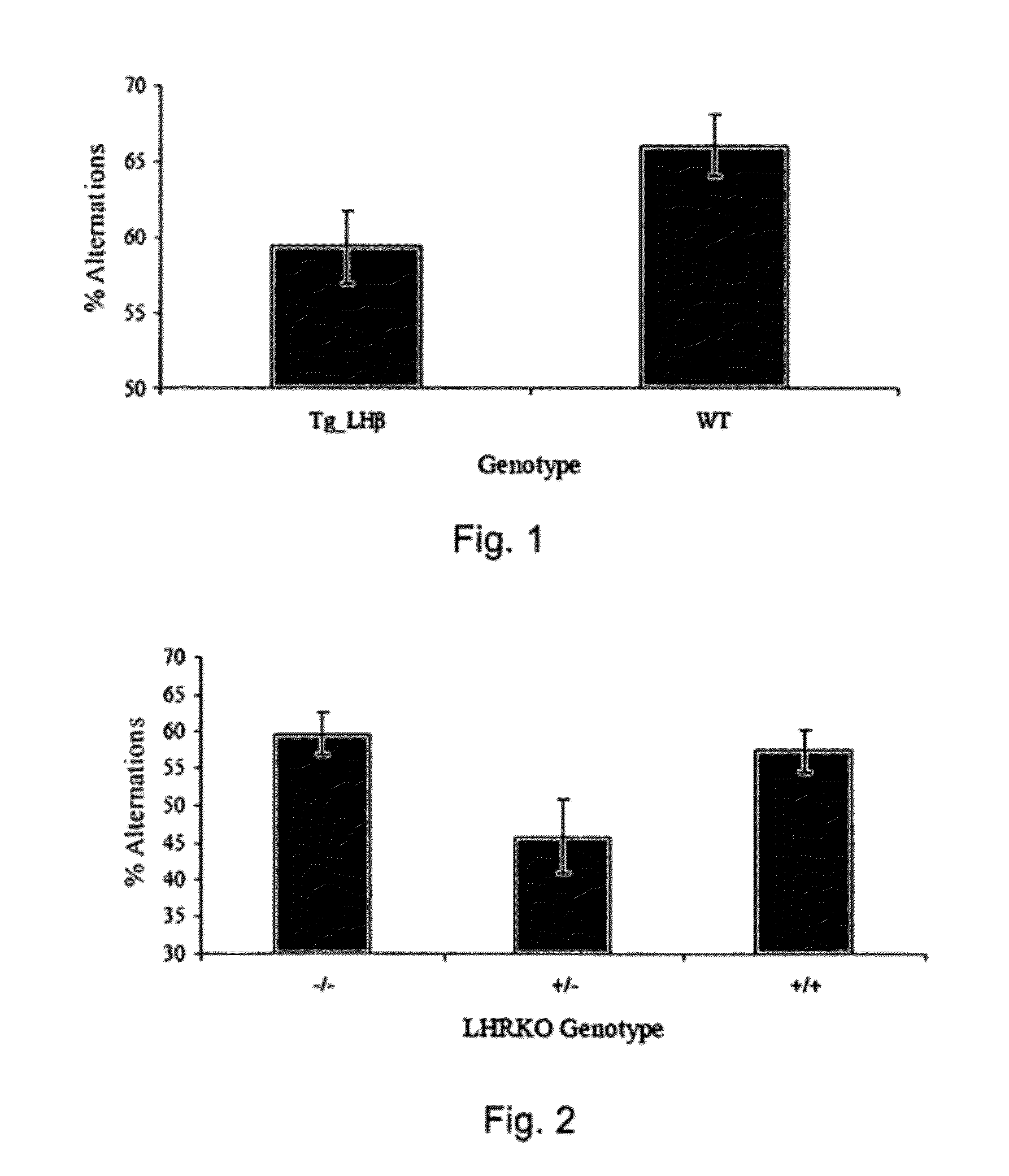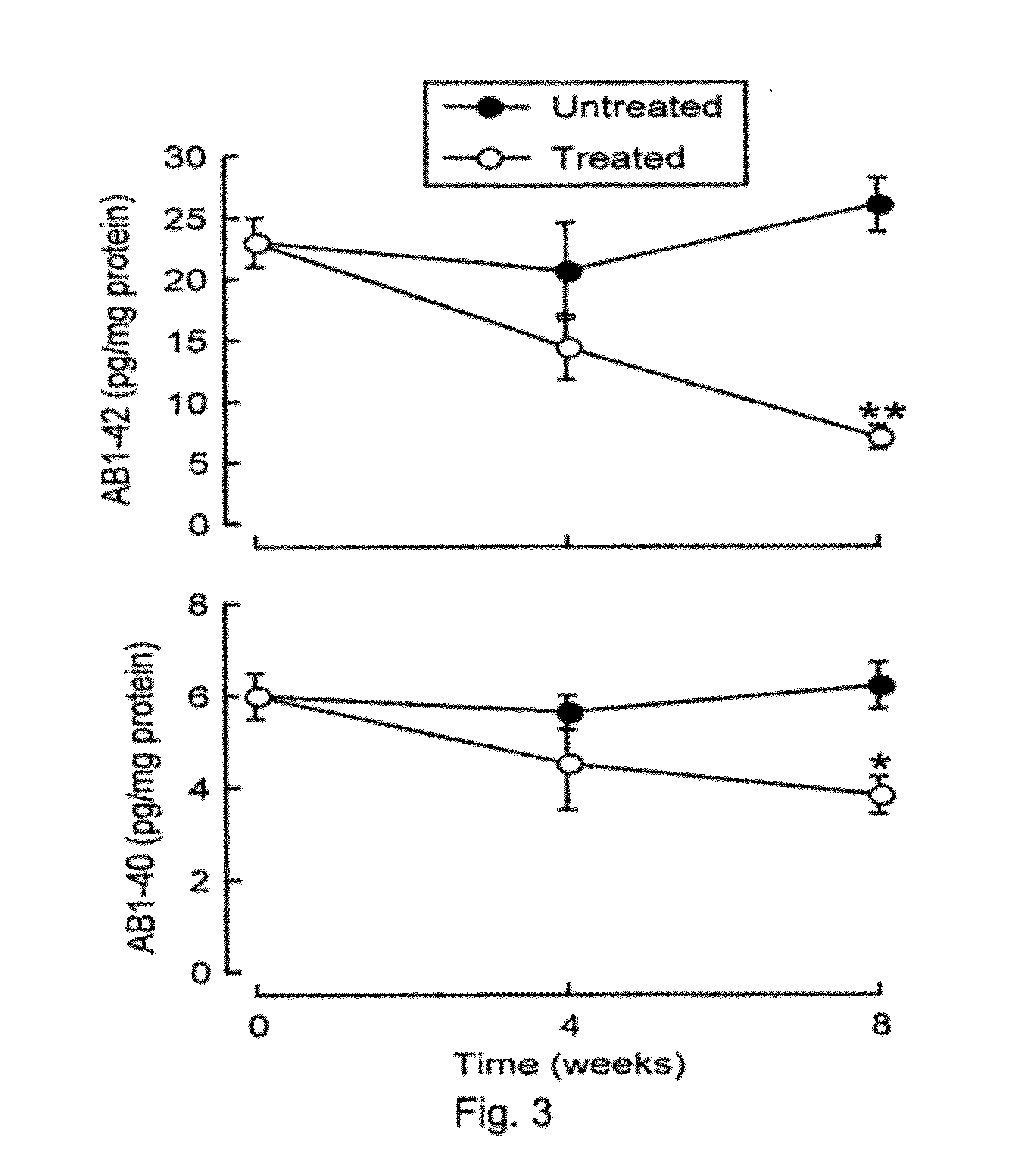Brain-derived gonadotropins and cognition
a brain-derived gonadotropin and cognition technology, applied in the field of neurodegenerative diseases, can solve the problems of difficult to determine the etiologic events leading to neuronal loss and dysfunction, and achieve the effect of preventing neurodegenerative diseases, reducing or eliminating the levels, production, and/or function of brain-derived gonadotropins
- Summary
- Abstract
- Description
- Claims
- Application Information
AI Technical Summary
Benefits of technology
Problems solved by technology
Method used
Image
Examples
example 1
Increases in Luteinizing Hormone are Associated with Declines in Cognitive Performance
[0060]In this study, we herein evaluated cognitive performance in two transgenic mouse strains, both with high LH but only one with functional LH receptors. LH receptors, as mentioned before, are found in high levels in the hippocampus, a region critical in the pathogenesis of AD. Therefore, testing LH-over-expressor mouse model such as the Tg-LHβ in addition to the LHRKO mouse models on a hippocampally-dependent task may allow us to determine whether cognitive changes are modulated as well as whether the changes are receptor specific in this region.
[0061]Additionally, an added bonus of these models is that Tg-LHβ and LHRKO have differential estrogen status. That is, while Tg-LHβ mice show high LH levels and high estrogen levels, LHKO mice show high LH levels but none-functional receptors and therefore below average levels of estrogen. This is important and relevant to AD since, as mentioned above,...
example 2
[0071]Based on these preliminary studies indicating that LH could be a factor in cognition and given that our group has previously reported that LH modulates amyloidogenic processing of AβPP (FIGS. 3 and 4), we evaluated the therapeutic potential of LH ablation, using a gonadotropin-releasing hormone analogue, leuprolide acetate, in aged (21 month old) Tg2576 female mice.
[0072]In this initial study we used aged animals to 1) circumvent the estrogen issue, since aged mice, like humans show estropause and 2) to examine the effects of LH ablation once the disease is well established. Our data indicates that LH ablation significantly attenuates cognitive decline (FIG. 5) (p<0.01) and decreases Aβ plaque load (p<0.05) (FIG. 6) as compared to placebo-treated animals. Therefore, our data suggests that, at least in aged AβPP transgenic mice, the positive effects of LH ablation override any negative effects of estrogen depletion Importantly, while alternation behavior also depends on the inn...
example 3
[0075]We present preliminary data gathered from a pilot study and that focuses on the effects of leuprolide acetate on cognition in ovariectomized animals with or without estrogen replacement immediately after surgery.
[0076]For this pilot 2 month old C57 / B6 female mice from Jackson Labs, were ovariectomized (n=40) them and either replaced them with 90-day time-release estrogen (n=20) or placebo pellets (Innovative research of America, F1) (n=18). 24 hours after surgeries and pellet implantations half of the animals were treated with either 0.9% saline an the other half with leuprolide acetate (7.5 mg / kg) for 3 months in an identical fashion to that previously reported (Casadesus et al., 2006). In addition we added a SHAM ovariectomized group that received saline and a placebo pallet (n=10). During the last two weeks of the study all animals have been tested for Y-maze and Morris Water Maze performance.
[0077]This supplemental material using Y-maze as a broad measure of cognitive func...
PUM
| Property | Measurement | Unit |
|---|---|---|
| time | aaaaa | aaaaa |
| volume | aaaaa | aaaaa |
| time | aaaaa | aaaaa |
Abstract
Description
Claims
Application Information
 Login to View More
Login to View More - R&D
- Intellectual Property
- Life Sciences
- Materials
- Tech Scout
- Unparalleled Data Quality
- Higher Quality Content
- 60% Fewer Hallucinations
Browse by: Latest US Patents, China's latest patents, Technical Efficacy Thesaurus, Application Domain, Technology Topic, Popular Technical Reports.
© 2025 PatSnap. All rights reserved.Legal|Privacy policy|Modern Slavery Act Transparency Statement|Sitemap|About US| Contact US: help@patsnap.com



